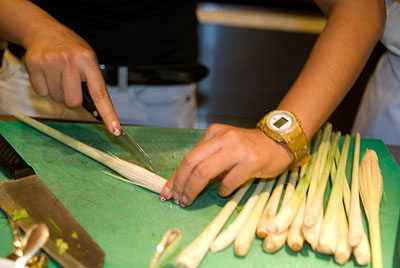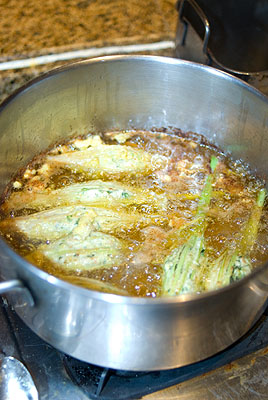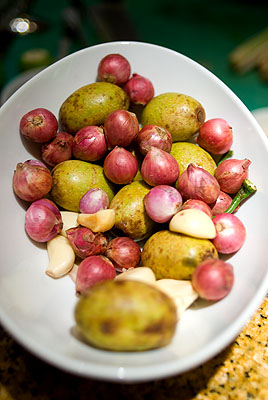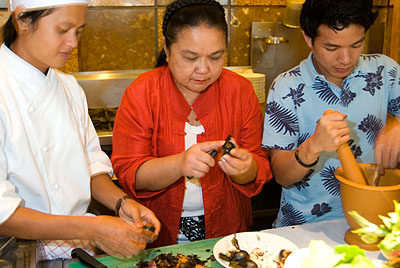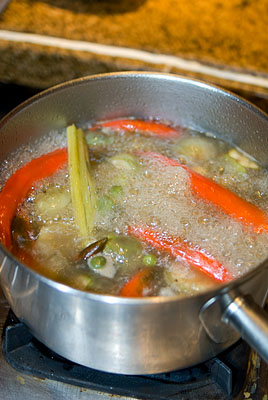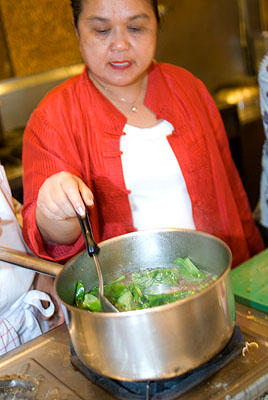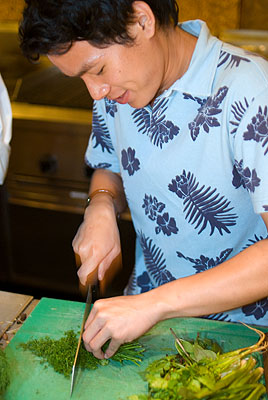Joy Ngeuamboupha (above) and Caroline Gaylard of Tamarind restaurant in Luang Prabang have been making their delicious Lao food at the Sheraton Grand Sukhumvit this week. As part of the occasion, a small, but elite group of the city's media was invited to take part in a cooking demonstration of three traditional Luang Prabang dishes taught by Joy himself.
Joy, a native of Luang Prabang province, and Caroline, an Australian, originally collaborated to make a cookbook of authentic Lao recipes. This led to, as these things do, a restaurant, and in 2005 Tamarind was born. Today their restaurant is still one of the only handful of places in Luang Prabang where visitors can sample authentic local dishes, and the owners have made it their mission to introduce people to authentic Lao food.
Before going through the dishes Joy taught us, here are a few tips from Joy about sticky rice, the Lao staple:
-Sticky rice should be soaked for 12 hours before cooking
-After soaking, the sticky rice needs to be washed three times; the first time gently squeezing the rice, the second two simply rinsing until eventually the water runs clear
-Sticky rice should be steamed for about 30-40 minutes, uncovered; when steam begins to rise from the top of the rice, take the sticky rice out, flip it over, and steam for another five minutes
-When the sticky rice is done, keep it in a katip, a permeable bamboo basket; keeping the sticky rice in a sealed container will cause it to become inedible mush
Oua Si Khai - Stuffed Lemongrass
Joy began by showing us how to make several long slices in the bottom parts of largish stalks of lemongrass:
After being softened (with a pestle) and opened, the stalks were then stuffed with a filling of ground chicken that had been blended in mortar and pestle along with salt, garlic, spring onions, coriander and kaffir lime leaf:
The lemongrass sticks were then dipped in an egg wash and deep-fried:
until the meat was just done, resulting in the finished product seen above.
Jaew Makok - A "Dip" of Roasted Chilies and Makok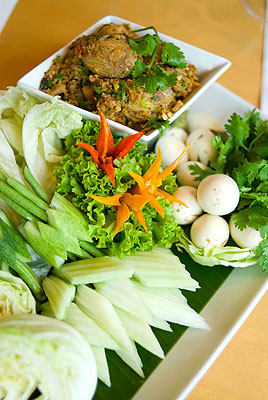
This one might be a hard dish for many of you to make at home, as makok, also known as hog plum, is undoubtedly quite hard to find abroad. I wouldn't really recommend substituting anything, but would just say that it's there to provide a sour flavour to the dish.
Joy had a bowl of previously-roasted chilies (the large ones called phrik chee faa), shallots, garlic and the makok, the green fruit shown below:
He told us to peel the burnt bits off before mashing the mixture up in a mortar and pestle along with some salt and that very Lao of flavourings, MSG:
To this mixture Joy added a handful of deep-fried pork rinds, some chopped coriander and green onions. Still using the mortar and pestle, he mixed the ingredients again, adding a few tablespoons of water as it was quite thick. The finished dip should be salty and sour in flavour, and is served with sticky rice and fresh veggies and herbs.
Or Lam - Thick Luang Prabang-Style Vegetable Stew
This is one of my favourite Luang Prabang dishes. It should have a spicy/bitter flavour, the result of the addition of sakhaan, a vine used in Luang Prabang cooking. Joy brought several chunks of sakhaan to Bangkok, and showed us how it should be used.
He began by peeling and quartering the sakhaan, and soaking it in water:
While this was soaking, Joy brought a couple stalks of lemongrass, a few round eggplants, a couple cloves of garlic and a handful of pea eggplants to a boil:
A few minutes later he added some sliced pork and the sakhaan. The mixture was left to simmer for about a half hour, or until as Joy said, "The eggplants are soft." When this was accomplished, he removed all the solid ingredients, except for the pork and sakhaan, reserving the broth. He then pounded the now-soft herbs and veggies in a mortar and pestle until a rough paste was formed. This paste was re-introduced to the simmering liquid, along with a couple tablespoons of paa daek (Lao-style fish sauce), chopped green beans, more pea eggplant, mouse-ear mushrooms (het huu nuu), tamlueng, a vine-like leaf, and khao buea, sticky rice that had been soaked in water then broken up into a course powder, a traditional thickening agent:
While this was simmering, Top was ordered to chop up a huge amount of dill, coriander, green onions, sawtooth coriander and Thai basil:
Which he happily did. When the most recently-added veggies were just about done, the chopped herbs were stirred in:
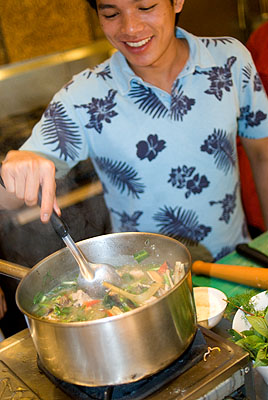
and the mixture left to simmer for a couple more minutes. Enjoy with sticky rice and Beer Lao.
If you just can't get enough Lao, check out this photo essay on Luang Prabang food I did for Lonely Planet a while back; a still-unpublished piece I wrote about Luang Prabang food; some super cool Lao recipes; and an article about Lao food I wrote that ran in the US food mag, Intermezzo.













